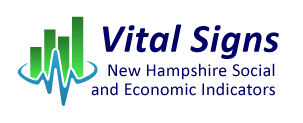Simple Primer about Components of Personal Income (print version ![]() )
)
Personal income represents total compensation received by individuals within the United States. This includes earnings from multiple sources, such as salaries, wages and bonuses received from employment; rental income; interest and dividends; and profit-sharing from a business, as well as unearned income like Social Security and food stamps, now called the Supplemental Nutrition Assistance Program (SNAP).1
The largest source of total personal income is earnings by place of work. However, to represent earnings received by individuals in New Hampshire, there are a couple of adjustments that need to be done to earnings by place of work. The first adjustment is due to mandatory government insurance obligations such as Social Security, which are deducted from the earnings stream, including the contributions made by employees, employers, and the self-employed. These deductions are subtracted from earnings by place of work because these earnings are not currently available to or received by individuals. Then an adjustment for residence is made to earnings to accommodate for those residents who commute to work in another state. The result is the net earnings by place of residence component of personal income. New Hampshire’s preliminary 2012 net earnings by place of residence accounted for 70.1 percent of total personal income, down 0.5 percentage points from 2011 annual estimates.

Two more components are added to net earnings by place of residence in order to estimate total personal income. First is dividends, interest, and rent income which includes dividends from stocks, all interest income and income from rental properties, as well as any royalty payments from patents, copyrights, or the rights to natural resources received by residents. Second is personal current transfer payments which includes income received for which there was no exchange of services or work, for example, Social Security or unemployment benefits. In New Hampshire in 2012, dividends, interest, and rent income increased by 0.3 percentage points over-the-year and personal current transfer payments edged up by 0.15 percentage points.
Per Capita Personal Income
New Hampshire’s size, both in residents and number of businesses, is difficult to compare with larger states like California and New York. Per capita personal income allows for an equalized comparison of personal income among states of different sizes. Simply put, per capita personal income (PCPI) is the result of dividing a state’s total personal income by the number of residents, including all persons, in the state. New Hampshire’s preliminary 2012 per capita personal income was $47,058. This was an increase of 2.6 percent over-the-year, ranking ninth highest among the states (not including District of Columbia) and higher than the national average of $42,693. As a matter of fact, five of the six New England states (excepting Maine) had a PCPI higher than the national average.
Anita Josten

1. Definition of ‘Personal Income’. Investopedia. <www.investopedia.com/terms/p/personalincome.asp>.
![]() Adobe Acrobat Reader format. You can download a free reader from Adobe.
Adobe Acrobat Reader format. You can download a free reader from Adobe.
Translation Resources and Disclaimer
New Hampshire Employment Security (NHES)
45 South Fruit Street | Concord NH 03301 | 603-224-3311 | 1-800-852-3400
TDD Access: Relay NH 1-800-735-2964





